Apiarist, Aquatic Park swimmer, and volunteer first-responder is as busy as the bees in her backyard
Beekeeper Gigi Trabant remembers vividly that spring day 11 years ago in the backyard of her Outer Richmond home when she began her new hobby: She got stung 35 times.
She had just been delivered her starter package: a bee family, or colony, in a small box: about 10,000 bees with the queen in a little cage. The next step was to install them in a hive – four or so stacked boxes to start, more added as the colony grows. A few days after putting the bees in their new home, Trabant reached into the hive to release the new queen.
An angry mob landed on her hand and planted their stingers. Having misplaced the protective gloves that came with the kit, her skin was exposed in the mesh-topped garden gloves she substituted. But, following her training, she stayed calm and moved slowly, withstanding the pain until she got her queen settled. Then, she put the top of the hive back and ran to the kitchen for cold water to stop the swelling.
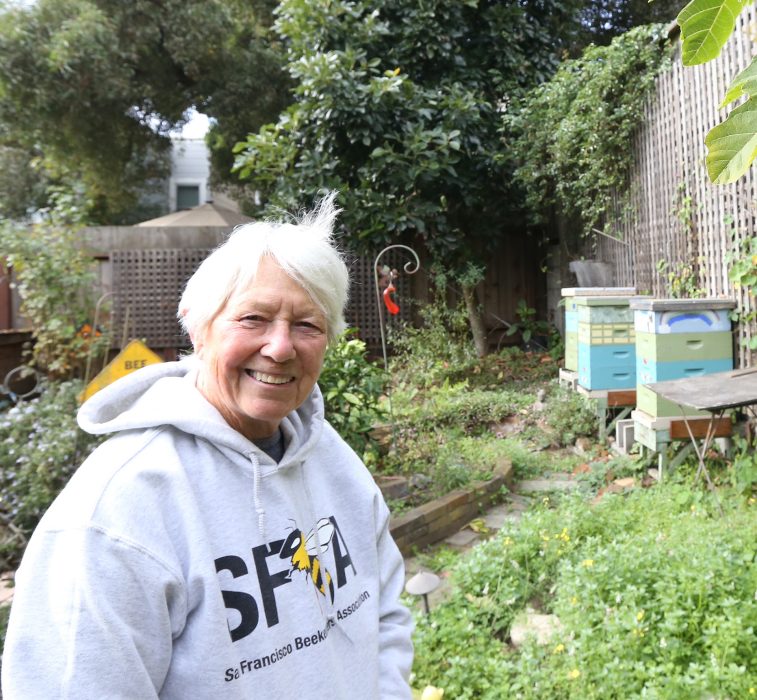
But before she could get her hand under the faucet, she momentarily passed out. Reviving on the floor, she stumbled off to bed. “I was OK in the morning, just a slight headache,” she said. She still gets stung occasionally but not by so many bees.
Honeybees are not aggressive by nature, but they are protective of their hive and can be irked by beekeepers probing to determine whether the queen is laying eggs, the larvae are healthy, the hive is not overcrowded and there is sufficient honey to feed the bees.
Bee not afraid
Trabant barely feels the occasional sting these days, but she makes sure to wear a full-body suit with veil for face protection – and the proper gloves.
Very little daunts her in the bee world – or any other, it seems – and she went on to become president of the San Francisco Beekeepers Association (SFBA) for eight years.
This 80-year-old, gray-haired grandmother is the poster child for “busy as a bee.” She tends thousands of bees in 15 bee boxes, volunteers at SFBA, rents her ground floor studio as a bed and breakfast – and rejuvenates with twice-a-week swims in the icy waters at Aquatic Park.
Bees and the association are the core of her life. She speaks to student and adult classes and gives demonstrations, reminding people that “we can’t live without them” – they pollinate a third of the nation’s crops.
Volunteering is the heart of her activities. When the association gets a request to lecture or demonstrate the ABCs of bee life, it goes out to the membership, and Trabant is a first responder.
In August, she and beekeeper Lynne Rousseau gave a demonstration for two dozen kids up to the 4th grade at a Visitation Valley daycare program. Watching live bees move around behind a glass slide in a demonstration hive box, the children were fascinated.
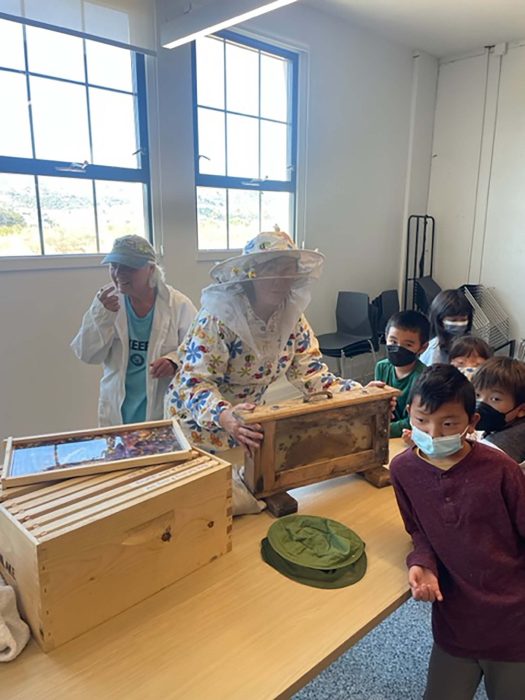
“They loved it – they ate it up!” she said. “The first thing they ask about is the queen. And, oh, they saw bee poop (on the glass) and that was exciting to them.”
In December 2011, the day she ended her 18-year nursing career, she walked into the Queen Bee supply store on Mission Street (gone now), basically trading one full-time occupation for another.
Then, after various jobs, marriage, and divorce, raising three daughters, getting bachelor’s degrees in psychology and nursing, and retiring from the career she loved, Trabant finally had the time.
Too much success
She was lucky that Philip Gerrie was in the Queen Bee that day. He was president of the then-80-member SFBA. “Philip got me started. First with classes, and then he was my mentor,” she said.
Trabant’s successes and diligence during two years of Blevins’ oversight led him to turn the SFBA presidency over to her. Last year, she stepped down for someone younger. In her eight-year tenure, membership had doubled.
“We have about 400 members now,” she said. “Maybe 100 are supporting family members. But I’d guess there are 1,000 beekeepers in the city.”
Asked if there was any similarity between caring for people, as a nurse, and caring for bees, she hardly paused. “I was a hospice nurse for 18 years at a Veterans Hospital and bees live only 42 days,” she said. “They’re always on the brink of dying.”
Despite following the best advice, Trabant’s first spring wasn’t foolproof. Other beekeepers had told her to stack the hive boxes between verdant vegetation next to fencing in a corner of the backyard,” she said, “and never tell the neighbors.”
Things were fine until the day half of one of her two colonies swarmed into her neighbor’s backyard. Her error may have been “too much success,” she reflected, “in growing a population into overcrowding.”
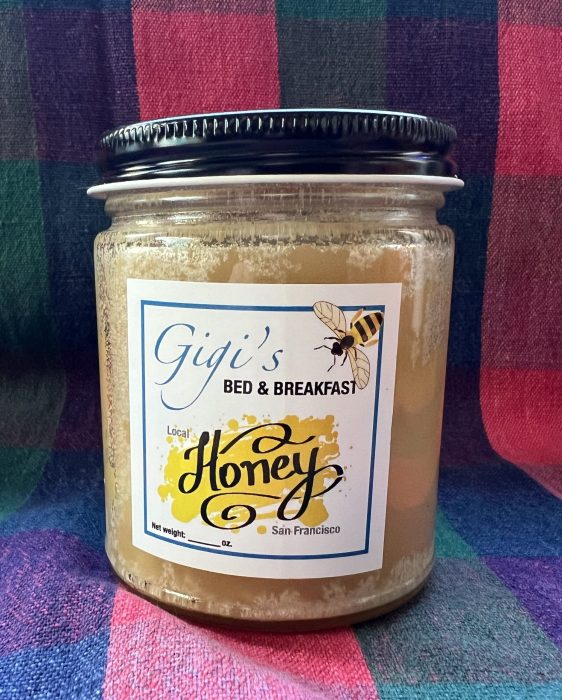
The breakout raised fears of nearby children getting stung. But none did and neighbors instead ended up fascinated as Trabant lured the swarm back. “The bees were on the fence and easily coaxed back into their boxes,” she said. “My neighbors actually loved it and became admirers.”
Traveling alone, bees can go five miles searching for nectar and pollen from plants and flowers and find their way back to their colony. But thousands of bees fleeing at once due to overcrowding is a swarm. It may look frightening, settled on a fence or tree branch, but swarms are typically docile, waiting to discover a new nesting place.
Trabant’s neighbors now benefit from the bees’ work. After each honey extraction – two to four times a year– Trabant gives everyone a jar of honey.
Off to college in her 40s
Born in Monterey, California in 1943, Trabant first became fascinated with bees in a school science class. She worked as an au pair at 17. Another job opportunity sent her to New York to work in the Time-Life library and then the photography laboratory. Her enthusiasm landed her in the promotions department.
After seven years in New York, she married a lawyer who chose to work in Paris, and she went back to where her parents lived. By 1977, now a family with three daughters, they moved to California so he could get an MBA degree at Stanford. But the marriage didn’t last.
Her girls went off to college in the 1980s and she did, too, getting a psychology degree at the age of 46 from San Francisco State University. By age 52, she had a nursing degree from the University of San Francisco and was soon hired at the Veterans Medical Center on Clement Street.
By then, she had bought a two-level home on 43rd Avenue, an easy walk north to the hospital. “Every day I said I was so lucky to have this job,” she said. “I loved being a support for a family, having the knowledge to know what to do and the interaction of the medical and social.”
Her transition to backyard bees has been the challenge she wanted, but it grew more demanding as she approached 80.
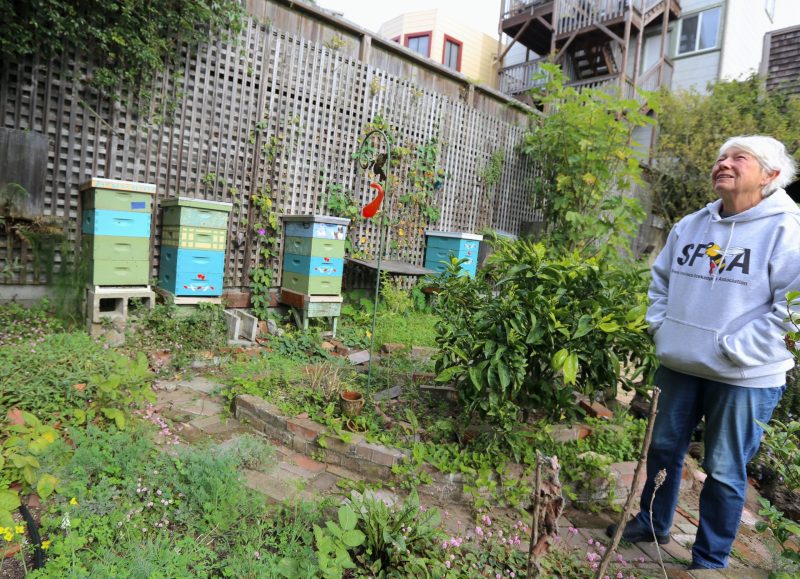
Boxes in a hive are fitted with removable wood frames, on which bees build wax combs. This is where their larvae are deposited. They survive on the nectar and pollen they bring in from flowers and plants, as well as the honey they produce, all of which are also stored in the cells of the comb. In San Francisco during a good year, a strong colony can produce two to three times more honey than it will need over the two to three months when little is blooming, according to the SFBA.
Hive workers keep it warm at 94 to 96 degrees for the queen, who may lay 1,500 eggs or more every day. “It’s a study of efficiency in its diversity,” Trabant said. “Every bee has a job.”
Heavy lifting
Beekeepers face many challenges. Overcrowding can lead to bee starvation and swarming. They can sometimes be retrieved but not always. Calling 311 will bring a swarm-catcher from SFBA.
Bees are also at risk from pesticides, climate change, and parasites. According to a survey by the universities of Auburn and Maryland, the last 12 months saw the second-highest death rate on record, with beekeepers losing nearly half of their managed colonies. A small mite called Varroa is the biggest increasing threat. “Last year, I lost all my colonies and had to buy two more,” Trabant said. “I don’t usually do that unless I don’t have any more bees.”
Since then, she has been using Oxalic Acid, an organic compound that kills 99 percent of the mites but doesn’t harm bees or contaminate the honey.
And she’s making sure her hives don’t get crowded. “We had to move a lot of frames and give new space,” she said recently. “As a result, we removed 12 honey-bound frames, which I extracted yesterday, and have three gallons of fresh honey.”
Trabant keeps the association’s barrel-size extractor, which uses centrifugal force to spin off honey, in her garage. She rents it to local beekeepers at honey gathering time.
“It’s enormous work,” she said. “I need a full day.” Each honey-bound frame can weigh up to eight pounds. “And you have to clean up right away. It’s a job. I can’t lift a full honey-bound box and need help.”
As a reward, she gave herself a “pre-birthday gift” – a special swim the next Saturday. She joined 500 swimmers from all over for the South End Rowing Club’s annual fundraising “Invitational.” She’s been a member for 12 years. They were boated to Alcatraz Island, then swam 1.25 miles back to Aquatic Park. Trabant’s 5-foot-2, 130-pound body mastered the swirling waters in one hour and 47 minutes. “At 67 degrees,” she exalted, “the water was wonderful.”
And she still had energy left for her regular 40-minute Monday swim.



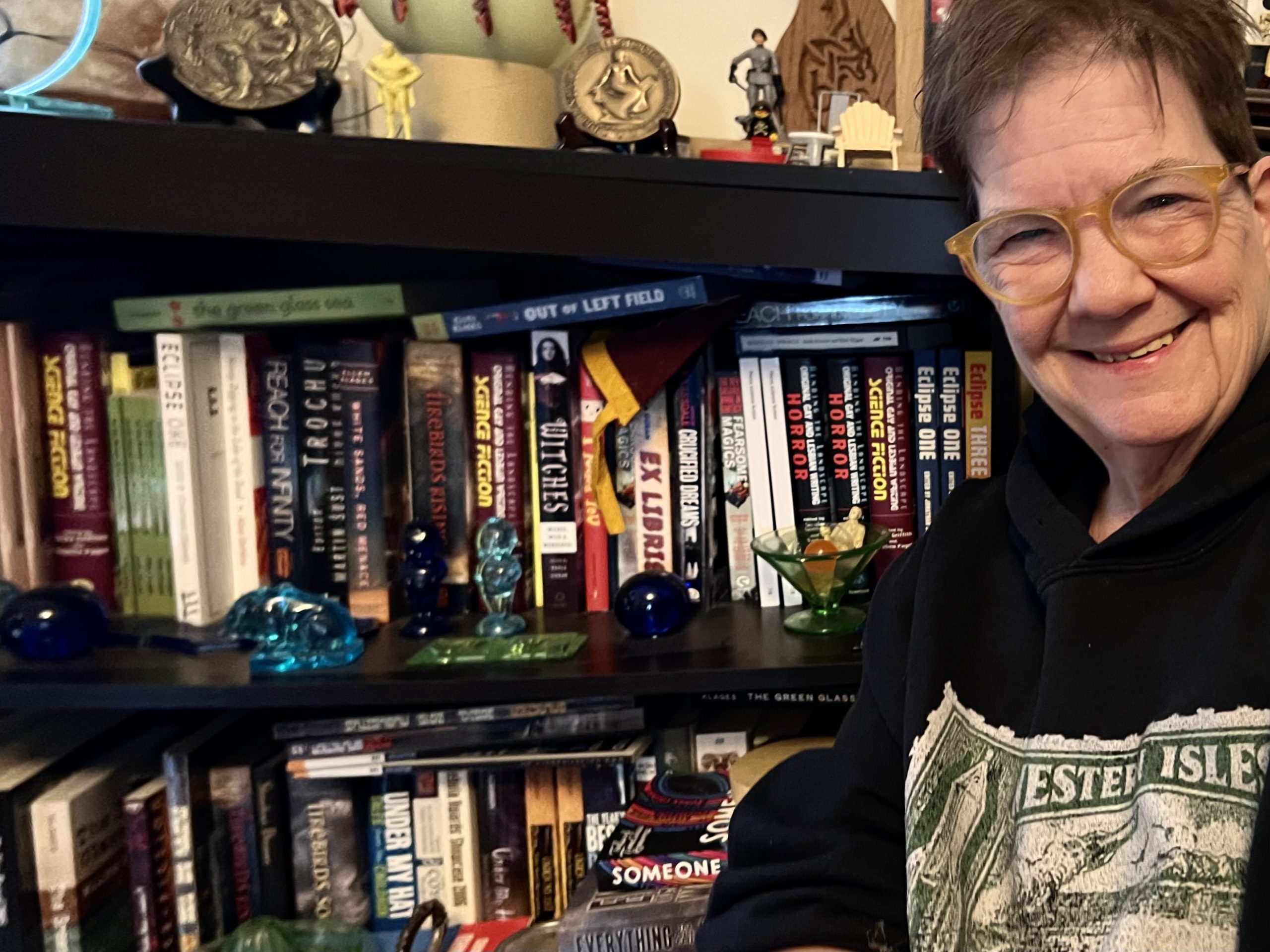


Geoffrey Link
Wonderful story, pleasantly told. Exactly why Senior Beat is so important to San Francisco's elderly.